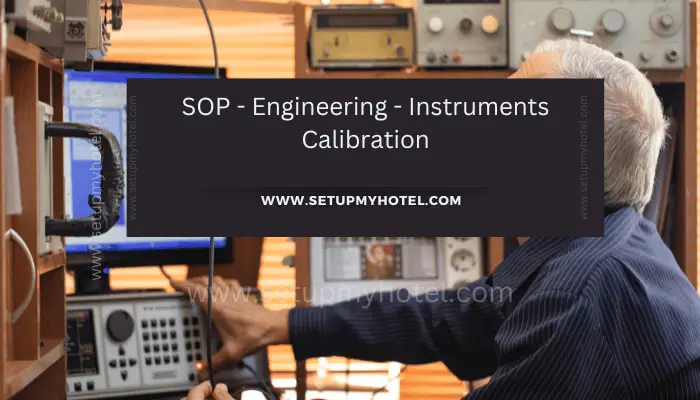Standard Operating Procedure for Engineering Instruments Calibration
Engineering instruments are widely used in various industries to collect data, monitor processes, and measure different parameters. However, it is essential to ensure that these instruments are accurate and reliable. This is where calibration comes in.
Calibration is the process of comparing the readings of an instrument with a known standard to determine its accuracy and make any necessary adjustments. It is a critical step in ensuring that the measurements obtained from the instrument are reliable.
Standard operating procedures (SOPs) are developed to provide a systematic approach to instrument calibration. The SOP for engineering instrument calibration should include the procedures for preparing the instrument, selecting the calibration standard, performing the calibration, and recording the results.
The SOP should also identify the frequency of calibration and the personnel responsible for performing the calibration. Regular calibration ensures that the instrument performs within its specified accuracy and reduces the risk of inaccurate measurements leading to faulty products or processes.
In conclusion, following SOPs for engineering instrument calibration is crucial to ensure accurate and reliable measurements, ultimately leading to the success of the process or product.
Instruments Calibration Standard Procedure:
- All instruments used in the hotel should be calibrated for 100% performance.
- An authorized person/agency should be called for the calibration of the instruments.
- To check the performance, readings/measurements should be taken at least seven days after calibration.
- Calibration should be done every year for all the measuring instruments.
- A master list of all instruments should be maintained to indicate which one is due for calibration.
- The frequency of calibration of each instrument should be mentioned on the list.
- A calibration schedule is prepared to indicate the month in which the instrument is due for calibration.
- Each instrument due for calibration is uniquely identified.
- Instruments should be calibrated by their manufacturer or by authorized service agencies.
- On receipt of the calibration certificate following needs to be checked:
- Calibration masters traceability to the national standard.
- Acceptance of error w.r.t defined acceptance norms.
- If the calibration report is found okay a suitable indicator in the form of a sticker indicating the next due date of calibration should be put on the instrument.
- In some cases, after calibration, the instrument is found out of calibration.
- In such cases, the calibration error is received by HOD Engineering along with the applicable department.
- Necessary action including change of calibration frequency is initiated.
- There is a possibility of any intentional or unintentional disturbance of the instrument setting.
- All users handling the instruments should be given training and instructions on the safe handling and storage of instruments.
Calibration Card Sample:
| Calibration Sticker / Card INSTRUMENT NAME : ___________________________ Id NO. / INVENTORY No : ___________________________ CALIBRATION NO. : ___________________________ CALIBRATION DUE ON : ___________________________ |
Training Summary questions:
- Why is it crucial to calibrate instruments regularly?
- What does the SOP recommend in terms of the frequency of instrument calibration?
- Who is responsible for performing the calibration according to the SOP?
- Explain the significance of maintaining a master list for instruments and how it aids in the calibration process.
- In case an instrument is found out of calibration, what steps does the SOP suggest taking, and who is involved in the process?
- Describe the information included in the Calibration Card/Sticker.
- What should be checked upon receiving the calibration certificate for an instrument?
- Why is it important to provide training to users on the safe handling and storage of instruments?
- How does the SOP suggest handling instruments found out of calibration, and what actions may be taken, including changes in calibration frequency?
- Explain the purpose of the calibration sticker or card on the instrument.
- What are the potential consequences of using instruments that are not regularly calibrated?
- Provide an example of a situation where an instrument may need its calibration frequency adjusted based on calibration results.
- How does the SOP recommend ensuring traceability to the national standard in the calibration process?
Patreon Only SOP Download
SOP Number: Hotel Engineering SOP – 21
Department: Engineering and Maintenance
Date Issued: 09–Mar-2018
Time to Train: 30 Minutes












